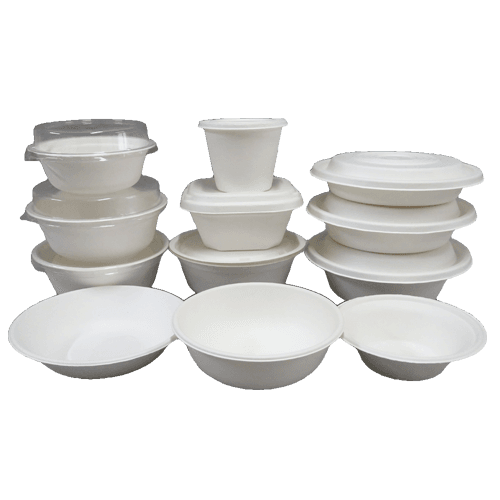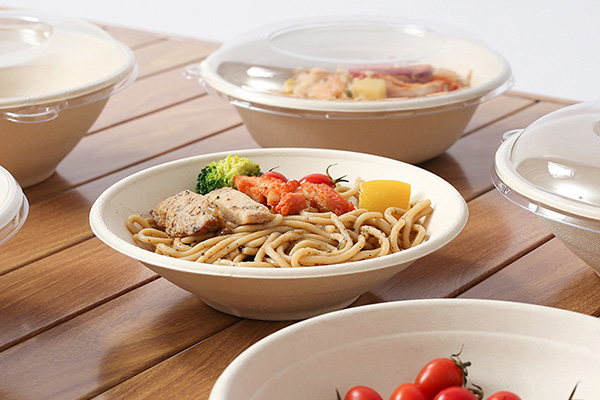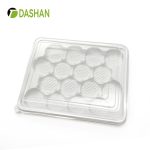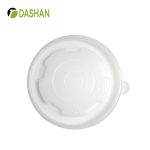Choosing the right salad bowl size—whether 12oz for light meals, 25oz for generous entrées, or 50oz for sharing platters—is key to food presentation, cost control, and customer satisfaction. This guide explores the full range of 12–50oz options, compares materials like PET, PP, cornstarch, and bagasse, and shares real-world cases from restaurants, delivery, and catering. Gain insights into durability, sustainability, and procurement to make smarter packaging decisions.
Introduction: Why Salad Bowl Size Matters
Salads have moved far beyond being a side dish. From quick-service restaurants (QSRs) to premium fast-casual chains and catering services, salads are now full meals, protein-packed builds, and even centerpiece catering items. Alongside this shift, packaging has had to adapt.
The size of a salad bowl determines not just portion control but also the dining experience, operational efficiency, and brand image. Too small, and customers feel shortchanged. Too large, and food costs increase or leafy greens get crushed under the lid.
In this guide, we’ll break down the full size range of paper and plastic salad bowls (12–50oz), explain which fits each menu type, and dive into the materials that matter most today: cornstarch, sugarcane bagasse, PP, and PET. We’ll also look at real-world cases from restaurant operations, retail grab-and-go, and catering.

Size Spectrum: From Sides to Catering
When choosing salad bowls, think of your menu as a spectrum:
-
12–16oz (355–473ml) → sides, fruit cups, kids’ portions
-
24–25oz (710–739ml) → standard single-serve salads
-
28–32oz (828–946ml) → protein-forward or grain-heavy builds
-
36–42oz (1065–1242ml) → large portions, pasta salads, sharing
-
44–50oz (1300–1479ml) → family-style or catering
Why 25oz Became the “Standard”
Most fast-casual salad programs have standardized on 24–25oz bowls. This size comfortably fits a base of leafy greens, 4–6 toppings, dressing, and a protein without looking sparse or overfilled. It’s also the sweet spot between portion satisfaction and food cost control.
A European case: many UK salad bars list the 25oz as their “regular,” while offering 32oz as a “large.”
A U.S. case: several American fast-casual brands rely on 32oz as their go-to, driven by consumer preference for grain-forward, protein-loaded bowls.

Real-World Sizing Scenarios
1. Side Salads and Fruit Portions (12–16oz)
Ideal for combo meals, school lunches, and kids’ menus. The small footprint saves storage space and pairs well with flat PET or cornstarch lids for visibility.
Example: A QSR chain offering a burger + side salad combo typically relies on 12oz bowls, ensuring portion consistency and cost control.
2. Standard Single-Serve (24–25oz)
This is the most versatile size. With 85% fill, a 25oz bowl looks abundant, balances greens and proteins, and avoids lid lift.
Example: A fast-casual salad bar in Germany uses 25oz kraft/cornstarch bowls for most menu items, printing logos directly on kraft for branding.
3. Protein- and Grain-Forward Salads (28–32oz)
When a salad build includes grains (quinoa, rice), cubed proteins (chicken, tofu), and 5–6 toppings, 32oz provides headroom without compressing ingredients. Dome lids are often needed.
Example: U.S. poke restaurants prefer 32oz PET bowls with dome lids, which show off colorful toppings in refrigerated grab-and-go displays.
4. Family & Catering (42–50oz)
For group sharing, catering trays, and large retail packs. Stability and lid lock are critical—bagasse or PP bowls with sturdy lids work best.
Example: Corporate catering providers use 50oz bagasse bowls with CPLA lids, ensuring plastic-free compliance in sustainability-focused markets.
Material Choices: Beyond Paper
Choosing the right material is as important as selecting the right size. Each material signals something different to customers and offers unique operational benefits.
🌱 Cornstarch Bowls
-
Eco credentials: Biodegradable and compostable in industrial settings.
-
Strengths: Resistant to oil and water; good for salads with dressing.
-
Use case: Brands emphasizing sustainability without sacrificing performance.
-
Pair with: CPLA dome lids or cornstarch lids for plastic-free sets.
🌿 Bagasse (Sugarcane Fiber) Bowls
-
Eco credentials: 100% plastic-free, made from agricultural waste.
-
Strengths: Strong, rigid, heat- and oil-resistant.
-
Use case: Catering, delivery, and ESG-focused businesses.
-
Pair with: Bagasse lids (for plastic-free) or CPLA dome lids.
🔹 PP (Polypropylene) Bowls
-
Eco credentials: Recyclable (where facilities exist).
-
Strengths: Lightweight, microwave-safe, durable.
-
Use case: Meal prep services, reheatable salads, mixed hot-and-cold menus.
-
Pair with: PP snap-on lids for leak-proof delivery.
🔹 PET (Polyethylene Terephthalate) Bowls
-
Eco credentials: Widely recyclable; rPET versions increase recycled content.
-
Strengths: Crystal-clear visibility; premium retail shelf appeal.
-
Use case: Deli counters, grab-and-go salad programs, retail displays.
-
Pair with: Flat or dome PET lids for maximum visibility.
Operations Considerations
Capacity vs. Real Fill
A “25oz” bowl is brimful with water, but salads are not water. Leafy greens compress; proteins don’t. Most operators aim for 80–90% fill to prevent dressing leaks and lid lift.
Lid Fit & Leak Prevention
-
Shake test: Fill bowl to 85%, secure lid, and shake 10 times.
-
Drop test: 1m drop—no leaks, no lid pop.
-
Condensation test: Store in a chiller for 1 hour; verify visibility and label adhesion.
SKU Rationalization
Smart procurement = fewer SKUs. A dual-size lineup (25oz + 32oz) with a shared lid system often covers 90% of menu needs.

Compliance & Certifications
-
Food contact: FDA, EU Food Contact, LFGB.
-
Compostability: EN13432 or BPI (for cornstarch and bagasse).
-
Quality systems: ISO, BRC, or IFS certifications from suppliers like Xiamen Dashan® help streamline audits.
Logistics & Cost Efficiency
-
Case counts: Align with weekly sales velocity to reduce waste.
-
Universal lids: One lid family across 25oz & 32oz bowls cuts costs.
-
Branding: Kraft/cornstarch bowls allow for digital short runs or flexo printing; bagasse supports embossing.
-
Container loading: PP and PET often stack more efficiently, lowering freight costs.
Expert Takeaways
-
If you’re new to salad programs, start with a 25oz + 32oz lineup.
-
If your brand focuses on sustainability, lean into bagasse and cornstarch with CPLA lids.
-
If retail visibility matters, PET is unmatched.
-
If delivery is key, prioritize leak-proof PP or bagasse with strong lids.
FAQ
Q: What size bowl is best for salads?
A: 25oz for standard builds; 32oz for protein-heavy bowls; 12–16oz for sides; 42–50oz for catering.
Q: What is the most common size in fast-casual?
A: 25oz dominates in Europe; 32oz is popular in the U.S.
Q: Which material is most sustainable?
A: Bagasse and cornstarch offer compostability; PET with recycled content (rPET) supports recycling systems.
Q: Can I microwave these bowls?
A: PP is microwave-safe; cornstarch and bagasse handle warm foods but aren’t suitable for full microwave reheating. PET is not microwave-safe.
Q: How do I reduce SKUs?
A: Choose two bowl sizes (25oz + 32oz) and standardize lids across them.
Conclusion
There’s no one-size-fits-all answer to salad bowls, but there are smart strategies. For most operators, a 25oz bowl is the workhorse, supported by a 32oz option for loaded builds and a 12–16oz for sides. Materials depend on your brand’s goals: cornstarch and bagasse for sustainability, PET for retail display, and PP for heat and delivery.
At Xiamen Dashan®, we provide a full portfolio—cornstarch, bagasse, PP, and PET bowls in sizes 12–50oz—to help restaurants, retailers, and distributors balance cost, operations, and sustainability. With global certifications and flexible customization, we deliver packaging that works as hard as your menu.
📚 References
-
Food Packaging Forum. (2023). Food contact materials and sustainability in packaging. Retrieved from: https://www.foodpackagingforum.org/
-
National Restaurant Association. (2024). Restaurant Industry Trends Report. Retrieved from: https://restaurant.org/research
-
European Bioplastics. (2023). Bioplastics market data. Retrieved from: https://www.european-bioplastics.org/
-
Packaging Europe. (2024). Innovations in sustainable foodservice packaging. Retrieved from: https://www.packagingeurope.com/
-
U.S. Environmental Protection Agency (EPA). (2024). Sustainable Management of Food and Packaging. Retrieved from: https://www.epa.gov/smm
-
Mintel. (2023). Global Foodservice Packaging Trends. Retrieved from: https://www.mintel.com/
-
Smithers. (2024). The Future of Foodservice Packaging to 2029. Retrieved from: https://www.smithers.com/
-
Sustainable Packaging Coalition (SPC). (2023). Design guidelines for sustainable packaging. Retrieved from: https://sustainablepackaging.org/
-
International Solid Waste Association (ISWA). (2023). Global waste management outlook. Retrieved from: https://www.iswa.org/
-
Statista. (2024). Market size of disposable food containers worldwide. Retrieved from: https://www.statista.com/
Disclaimer & Copyright Notice
This article is created by the Dashan Packing editorial and research team.All information presented here is for educational and industry reference purposes only.Some data and standards cited in this article are sourced from publicly available materials,official regulatory documents, or third-party publications, which are properly credited where applicable.
All rights to third-party trademarks, images, and content belong to their respective owners.If any copyrighted material has been used inadvertently, please contact us at angel@chndashan.com.We respect intellectual property rights and will promptly remove or revise any material upon verification.





